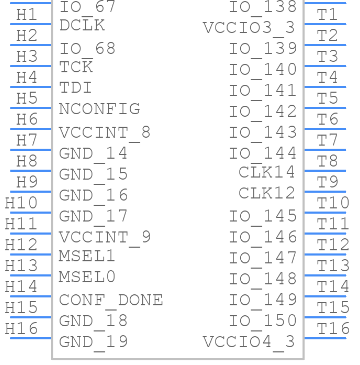EP4CE15F17C8N FPGAs: Features, Applications and Datasheet
2025-07-30 11:20:09 561
EP4CE15F17C8N Description
The EP4CE15F17C8N is a member of Intel (formerly Altera) Cyclone IV E FPGA family, designed for cost-sensitive and power-efficient applications while offering significant logic density and embedded memory. Fabricated on a 60 nm process, it provides a balance between performance, low static power, and affordability. The device is packaged in a FineLine BGA-256, optimized for compact board layouts.
EP4CE15F17C8N Features
Logic Elements (LEs): ~15,408
Embedded Memory: 516 Kbits distributed in M9K RAM blocks
Multipliers: 56 dedicated 18×18 multipliers for DSP-intensive applications
Phase-Locked Loops (PLLs): 4 PLLs for clock management and frequency synthesis
I/O Count: Up to 179 user I/Os with support for multiple voltage standards (1.2V, 1.5V, 1.8V, 2.5V, 3.0V)
Package: FBGA-256 (17 × 17 mm)
Operating Speed Grade: C8 (commercial, 0°C ~ 85°C)
Low Power Design: Optimized static power consumption ideal for battery-operated systems
Configuration: Supports Active Serial (AS), Passive Serial (PS), JTAG, and external memory boot
EP4CE15F17C8N Applications
Industrial Automation: PLC controllers, motor drives, and process monitoring
Consumer Electronics: Digital image processing, video scaling, and display controllers
Communications: Low-cost baseband processing and networking equipment
Medical Equipment: Portable diagnostic tools and signal acquisition systems
Embedded Systems: Custom coprocessors, hardware accelerators, and flexible I/O interfaces
Education & Prototyping: Popular for FPGA-based labs and teaching due to its cost efficiency
EP4CE15F17C8N Alternatives
EP4CE22F17C8N (Cyclone IV, higher logic density, 22K LEs)
XC6SLX16-2CSG324I (Xilinx Spartan-6, comparable density and cost)
LFE2M20E-5FN256C (Lattice ECP2M, mid-range FPGA with DSP focus)
10M16SAU169C8G (Intel MAX 10 FPGA, similar density, with integrated flash)
LCMXO2-1200HC-4TG144C (Lattice MachXO2, non-volatile, lower-power alternative)
EP4CE15F17C8N CAD Model
Symbol

Footprint

3D Model


EP4CE15F17C8N Manufacturer
Intel Corporation is a global leader in semiconductor technology, headquartered in Santa Clara, California, USA. Founded in 1968 by Robert Noyce and Gordon Moore, Intel pioneered the development of the modern microprocessor and has since become one of the world’s most influential technology companies.
Intel designs and manufactures a wide range of products, including microprocessors, chipsets, graphics solutions, FPGAs, memory, networking, and AI accelerators. The company is best known for its Intel® Core™, Xeon®, and Atom® processor families, which power everything from personal computers to enterprise servers and cloud infrastructure.
Beyond traditional CPUs, Intel plays a leading role in 5G, autonomous driving, data center solutions, edge computing, and artificial intelligence, with acquisitions such as Altera (FPGAs), Mobileye (autonomous driving), and Habasit (networking) expanding its technology portfolio.
With its commitment to Moore’s Law, Intel continues to push the boundaries of semiconductor manufacturing, currently advancing through advanced process nodes such as Intel 7, Intel 4, and beyond. The company operates cutting-edge fabs worldwide and is heavily investing in foundry services through Intel Foundry Services (IFS) to strengthen global semiconductor supply chains.
Today, Intel remains at the forefront of driving the digital revolution, enabling innovations across industries including cloud computing, healthcare, telecommunications, artificial intelligence, and smart devices, while pursuing sustainable and energy-efficient manufacturing practices.
EP4CE15F17C8N FAQs
1. What is the maximum operating frequency achievable on the EP4CE15F17C8N?
The device typically supports internal logic clock frequencies of up to 250 MHz, depending on the implemented design and timing closure.
2. How does the EP4CE15F17C8N handle clock management in multi-clock systems?
It provides four PLLs with fractional multiplication/division capability, enabling fine-tuned clock generation, jitter filtering, and phase alignment for synchronous designs.
3. Can the EP4CE15F17C8N support soft-core processors like Nios II?
Yes. The FPGA can host the Nios II soft-core processor, allowing embedded processing with peripheral integration and custom hardware accelerators.
4. What configuration memory devices are compatible with this FPGA?
It supports EPCS serial configuration devices for Active Serial mode, external flash, or SRAM in Passive Serial mode, in addition to JTAG for direct programming.
5. How does the device ensure signal integrity in high-speed I/O designs?
The EP4CE15F17C8N integrates programmable slew rates, on-chip termination, and support for LVDS (up to 840 Mbps) to maintain signal integrity across various I/O standards.




